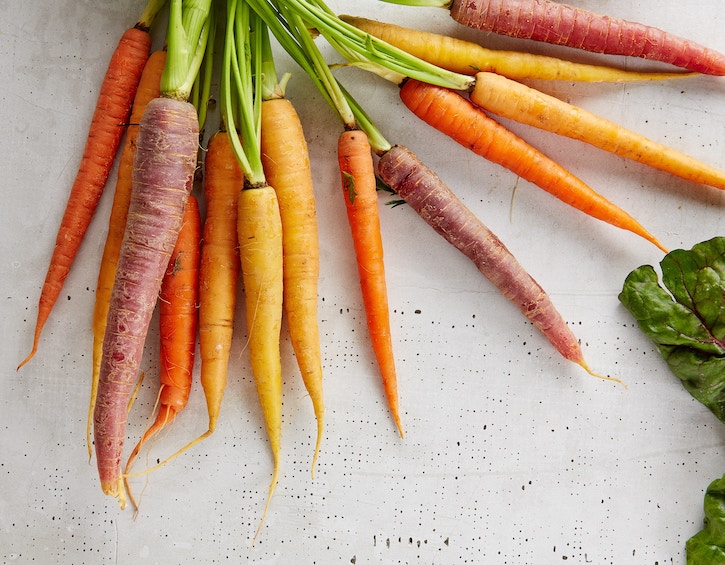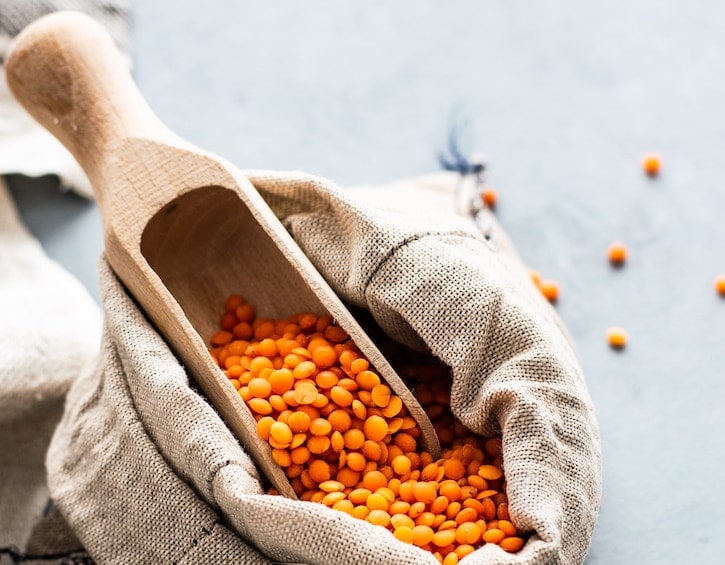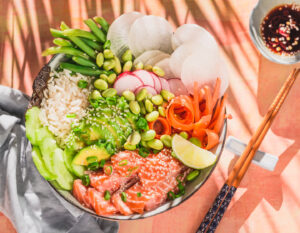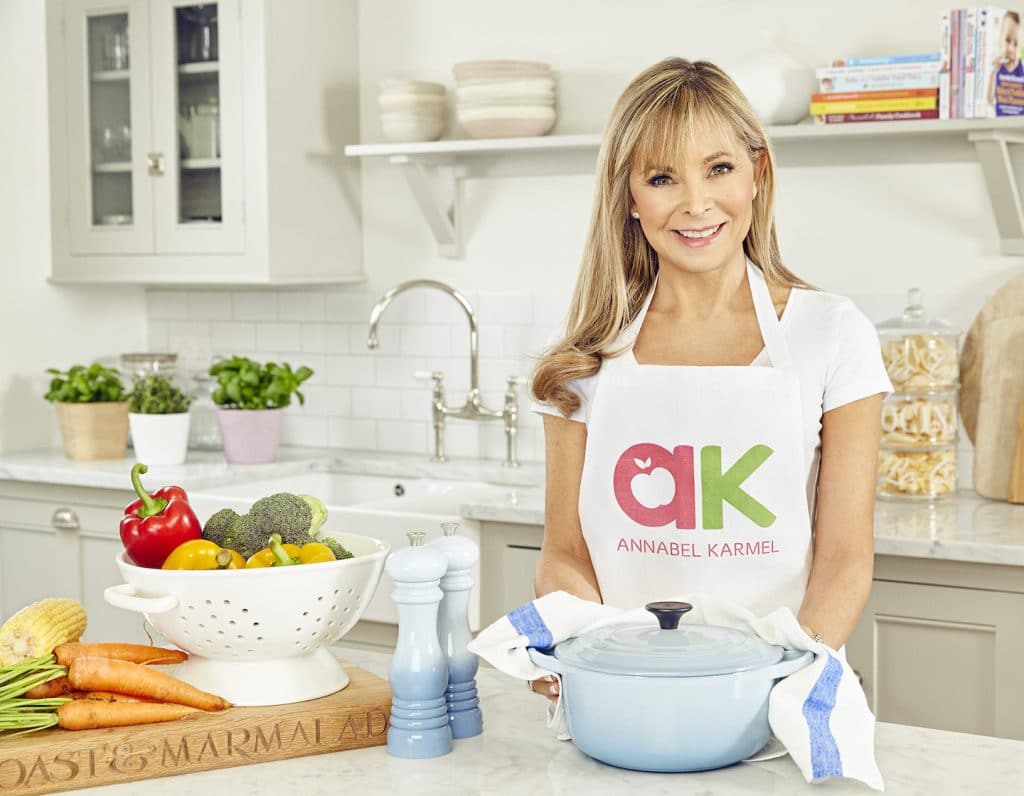
Everything you need to know about starting solids.
Just when most parents finally feel like they are getting to grips with daily milk rounds, they’re propelled into the wondrous world of weaning. It’s such an exciting milestone, but it’s a new art to master and at times can feel equally as unnerving as exciting. So, I wanted to share with you my essential guide to all things weaning to ensure your foodie journey is less fearful and more…fun!
Jump to:
When to start?
The Best First Foods
Critical Nutrients
Fussy Eating
Recipes:
Aromatic Beef with Sweet Pepper & Apricots
Salmon, Sweet Potato & Spinach Puree
Yummy Veggie Fried Rice
Salmon & Vegetable Parcel
Read more: Easy Breakfast Recipes From One Wholesome Meal
When to start?
The general rule is around six months old, as at this age your baby’s regular milk will no longer provide them with all the nutrients they need – iron, in particular, and their stores of these essential nutrients start becoming depleted by this stage. This is one reason why now is the ideal time to begin weaning, as missing nutrients need to be provided by food. However, all babies are different, and some will show signs of being ready a little before this (which is fine) but just not before four months (17 weeks) as their digestive systems aren’t quite mature enough at this point.
Each baby will develop at their own pace (and you’ll need to follow this pace too) but there are a few key signs to look out for which suggest they are ready to get started:
- Sitting-up and supporting their own head
This doesn’t have to mean sitting-up completely unsupported, just as long as they can sit-up for 3 to 5 seconds on their own. - They’ve developed hand-to-eye coordination
They need to be able to coordinate food and direct it into their mouth. Are they trying to stick fingers, fists (and everything in sight) into their mouth? This is a good sign they’ve mastered this skill. - They’re showing signs of losing an early baby reflex, called tongue-thrust
Tongue-thrust is a protective safety mechanism babies are born with to prevent them from choking. A little tip; place the tip of a clean finger or base of a clean plastic spoon on your baby’s bottom lip. If their tongue moves forward, then the reflex is still there. If they open their mouth and their tongue is at back then reflex has gone. The latter is a sign that they might be ready.
It is entirely up to you as to when you decide to get started as it will be a case of fitting in with your family’s routine. However, you might find it useful to consider the following:
- When your baby is most alert – perhaps after a nap and not directly before.
- Not hungry but not full – they might get frustrated if they are very hungry and struggling to get to grips with these new skills. You also don’t want them to be too full with no appetite for their first tastes, so try and pick a time in between feeds.
- Pick a familiar, relaxed environment.
- It can also help to establish a routine. I would suggest introducing new food during the day. This also means that in the unlikely case your baby has a reaction, you can monitor and manage it in the daytime.
The Best First Foods
Keep the first solid foods simple. I would recommend starting with a single fruit or vegetable. Root vegetables such as carrots, sweet potato and butternut squash are very popular first foods – they are easy to digest, can easily be pureed to a smooth texture and they have a naturally sweet flavour (similar to breastmilk). My First Veg Puree is great to get started with. Research has shown that bitter vegetables such as spinach, broccoli or cauliflower can be difficult tastes for babies to accept, but if you introduce these tastes sooner rather than later, they will be more receptive to new foods before they reach ten months. So be sure these bitter-tasting veggies feature on the menu in the early days; try my Sweet Potato, Pear & Broccoli Puree as a good starting point.
From six months, however, your baby will need more than just fruit and vegetables, and you will need to make sure you are starting to introduce iron-rich foods such as meat, lentils, eggs and iron-enriched cereals, as well as foods rich in essential fatty acids from oily fish (like salmon). Remember, the transition to solids is more about introducing food than giving a full meal. Your baby will need at least 600ml of breast milk or formula each day until they’re at least twelve months old, when their diet is varied enough to offer the correct balance of nutrients.
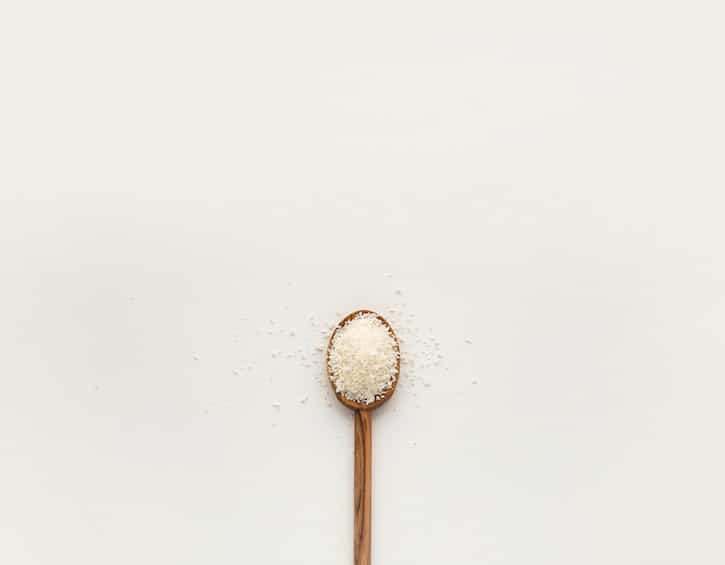
Baby-led or spoon-led?
It’s all about choosing the method which suits you, your baby and what works with your family’s routine. Personally, I favour the flexible approach, combining an element of baby-led weaning (soft finger foods) alongside spoon feeding (purees). Whichever weaning method you adopt, by around six months you should be offering your baby soft finger foods and mashed food (rather than finely blended purees) anyway. And, if you are baby-led weaning, you should still offer smooth-textured foods such as yoghurt, as they will need to explore and accept this texture.
If you do want to try baby-led weaning exclusively, you will just need to ensure that your child is developmentally ready. For example, with babies who are ready to wean earlier than six months, baby-led weaning won’t be suitable. Some babies at six months might not have fully mastered the skill of being able to pick up food and take it to their mouth. This is where pureeing or mashing essential iron-rich meat, for example, becomes important to ensure they are still getting those key nutrient-dense foods that they cannot feed themselves.
How to prepare first finger foods
Your baby will need to be able to close their hand around the food, so a fairly long piece of food with a part sticking out that they can hold in their fist is a good rule to follow. Steamed carrot batons, wedges of sweet potato, mango, papaya, avocado or cut up eggs are all great.
Critical Nutrients
At six months, your baby is about to go through an amazing growth spurt. In their first year, babies triple their birth weight. To grow that much, they need a lot of nutrients – more than at any other time in their life. But, be mindful that their tiny tummies fill up very quickly. This means that every mouthful or spoonful needs to contain the maximum amount of nutrition (with a minimum amount of bulk). Each meal should contain protein, carbohydrates and fat. You also need to make sure that their diet includes all important iron, essential fatty acids, zinc, Vitamin D, C, E, iodine and calcium. Iron and essential fatty acids top the charts in terms of importance:
Iron
Iron is so important for your baby’s brain development, especially from six months when the iron inherited from a baby’s mother runs out. They will absorb iron from meat more easily than iron from any other food source. You should be aiming to offer your baby iron-rich foods twice a day. If you follow a vegetarian diet, then don’t worry, there are plenty of non-meat sources that contain iron such as pulses (lentils, chickpeas for example), green leafy veggies, fortified cereals, wholegrain pasta, bread and egg yolks. However, as these are plant-based, the absorption of this form of iron is lower, so the amount required is slightly higher and combining these foods with a vitamin C-rich food will help the absorption of iron. Try a floret of broccoli or a few strawberries cut up alongside their meal.
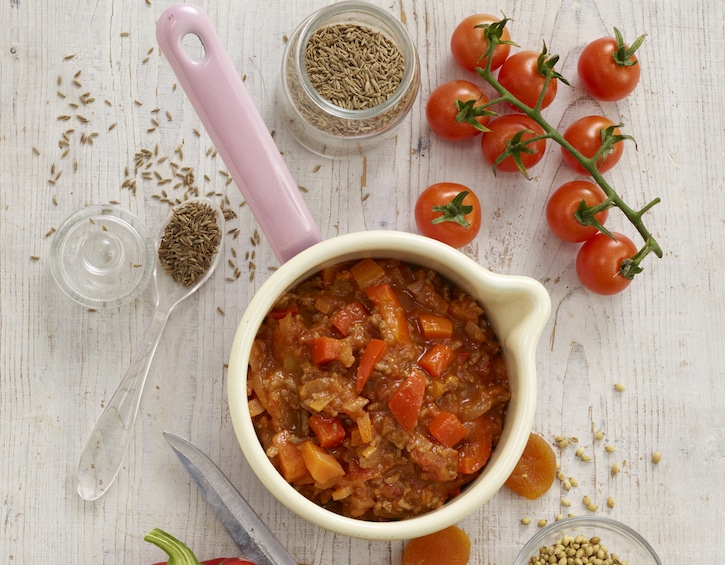
Aromatic Beef with Sweet Pepper & Apricots
(Suitable from 6 months+)
Makes 4 portions
Ingredients
1 tbsp olive oil
1 onion, chopped
3 carrots, peeled and diced
4 dried apricots, chopped
½ red pepper, deseeded and diced
1 clove garlic, crushed
150g lean minced beef
½ tsp cumin
½ tsp coriander
1 x 400g can chopped tomatoes
1 tbsp sundried tomato paste
150ml water
Method:
- Heat the oil in a saucepan.
- Add the onions, carrots, apricots, red pepper and garlic. Fry for 2 to 3 minutes, then add the minced beef and spices and brown with the vegetables.
- Add the tomatoes, tomato paste and water.
- Bring to the boil, cover with a lid and simmer for 20 minutes until tender.
- Blend to the desired consistency.
Essential Fatty Acids
Also known as omega 3 or DHA – these are the cream of the crop when it comes to fat intake and vital for the development of retina in the eye as well as brain growth and development. You should include a serving of oily fish twice a week, but no more for baby. You can opt for salmon, mackerel and sardines. Flaxseeds, chia and soya beans contain a different kind of Omega 3 called ALA, which the body has to convert into DHA, which means it is not as beneficial as the type you get from oily fish, but provides a little helping hand nonetheless.
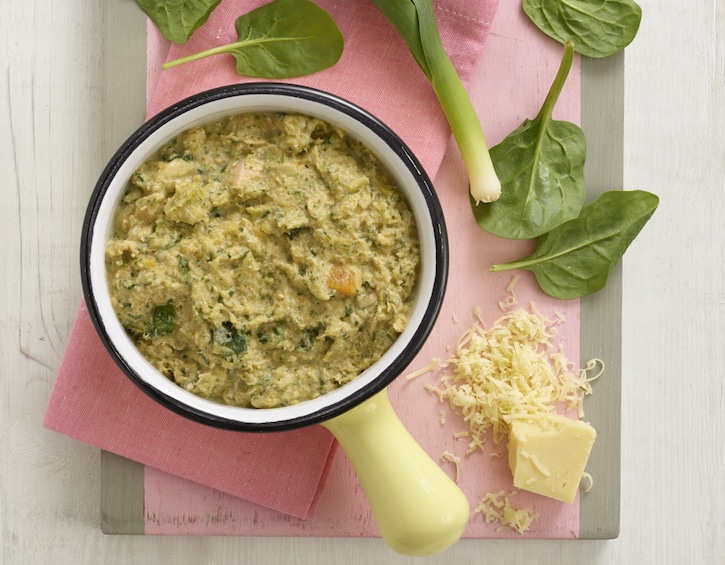
Salmon, Sweet Potato & Spinach Puree
(Suitable from 6 months+)
Makes 5 portions
Ingredients
2 tsp olive oil
1 leek, washed and chopped
200g peeled sweet potato, diced
150g fresh tomatoes, chopped
175ml unsalted or weak vegetable stock, or water
120g salmon fillet, skinned, cubed
50g baby spinach
5 fresh basil leaves
20g grated Parmesan cheese
Method
- Heat the oil in a small saucepan, add the leek and potato and fry for a few minutes, then add the tomatoes and stock or water.
- Bring to the boil, reduce the heat, cover and simmer for 12 to 15 minutes.
- Add the salmon and spinach and cook for 3 to 4 minutes until cooked through. Add the basil and cheese, then puree in a blender until it reaches the desired consistency.
Fussy Eating
If you’ve been blessed with a picky eater, please don’t worry – we’ve all been there! I had three of them, with daily battles on my hands. In fact, 90% of children go through at least one lengthy stage of fussy eating. Only giving them the foods they enjoy will escalate their fussiness and deprive them of the essential nutrients they need to grow and develop. The key is to offer as many different foods, flavours and textures as you can early on and remember that your little one may need to try a new food 10 to 15 times before they are willing to eat it. There are so many foods to try, so don’t fixate on one and try it again later. And, as babies approach their first birthday, they start to step (or crawl) out on their own – and mealtimes are no exception. Try to encourage your little one’s new-found sense of independence with a range of tasty and nutritious family meals full of flavour. Here are a couple of my favourites:
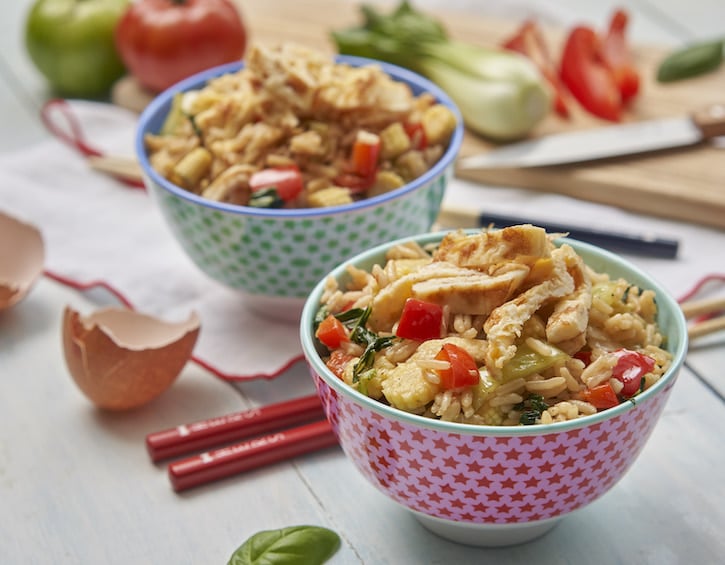
Yummy Veggie Fried Rice
(Suitable from 12 months+)
Makes 4 portions
Ingredients
1 tbsp sunflower oil
2 eggs, beaten
4 spring onions, sliced
½ red pepper, diced
1 clove garlic
1 small pak choi, sliced
250g cooked long grain rice
1 to 2 tbsp soy sauce
1 tbsp sweet chilli sauce
Method
- To make the omelette, heat half of the oil in a large frying pan. Add the egg and swirl around the pan to make a thin layer. Cook for 2 to 3 minutes and then transfer to a plate, roll up and slice into strips.
- Heat the remaining oil in the pan. Add the spring onion, pepper and baby corn. Fry for 3 to 4 minutes. Add the pak choi and garlic and fry for 2 minutes. Add the rice, soy and sweet chilli sauce. Toss over the heat and finish by adding the shredded omelette.
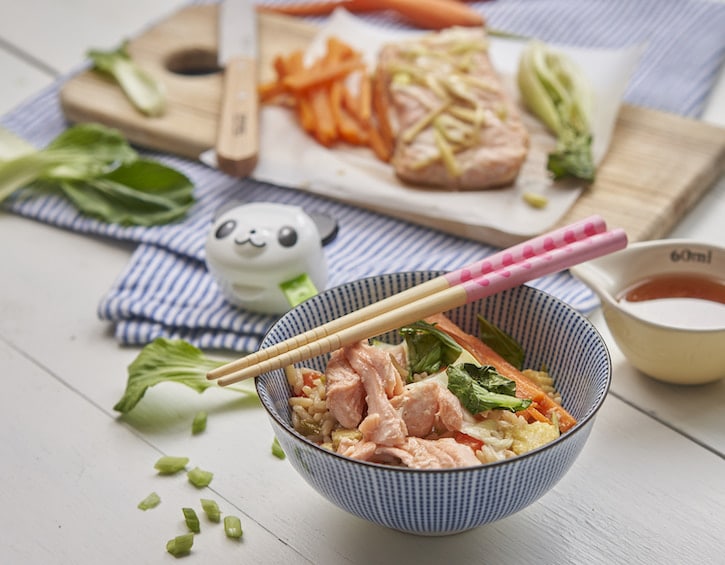
Salmon & Vegetable Parcel
(Suitable from 12 months+)
Makes 2 portions
Ingredients
2 salmon fillets
Small pieces of ginger, peeled and finely sliced
2 spring onions, sliced
1 carrot, peeled and finely sliced into thin strips
1 baby pak choi, halved
Sauce
2 tsp soy sauce
1 tsp mirin
2 tsp plum sauce
Method
- Cut two sheets of foil into squares. Put a small square of baking paper on top of one of these sheets.
- Put the salmon in the middle. Put one half of the pak choi next to the salmon and the carrot on the other side. Place the ginger and spring onions on top of the salmon fillet.
- Mix the sauce together in a small bowl. Pour over the salmon then fold over the second sheet of foil and seal the edges.
- Cook in a steamer for 10 to 12 minutes.
Read more: Baby-Led Weaning: Annabel Karmel’s Tips & Recipes to Get You Started
Serving up quick and healthy meals on jam-packed days is often easier said than done. The UK’s No. 1 children’s cookery author and food expert, Annabel Karmel, has come to the rescue and turned her most popular weaning recipes from her much-loved cookery books into nutritionally balanced on-the-go pouches for busy days. With 11 different flavour combinations to choose from, Annabel’s new “Organic Stage 1 Baby Purees” include only the best natural ingredients with 100% fruit, vegetables and natural coconut milk – and nothing else. Find them in ParknShop and YATA stores and online at Watson Baby. For more information visit www.annabelkarmel.com.
 View All
View All











 View All
View All





 View All
View All


 View All
View All








